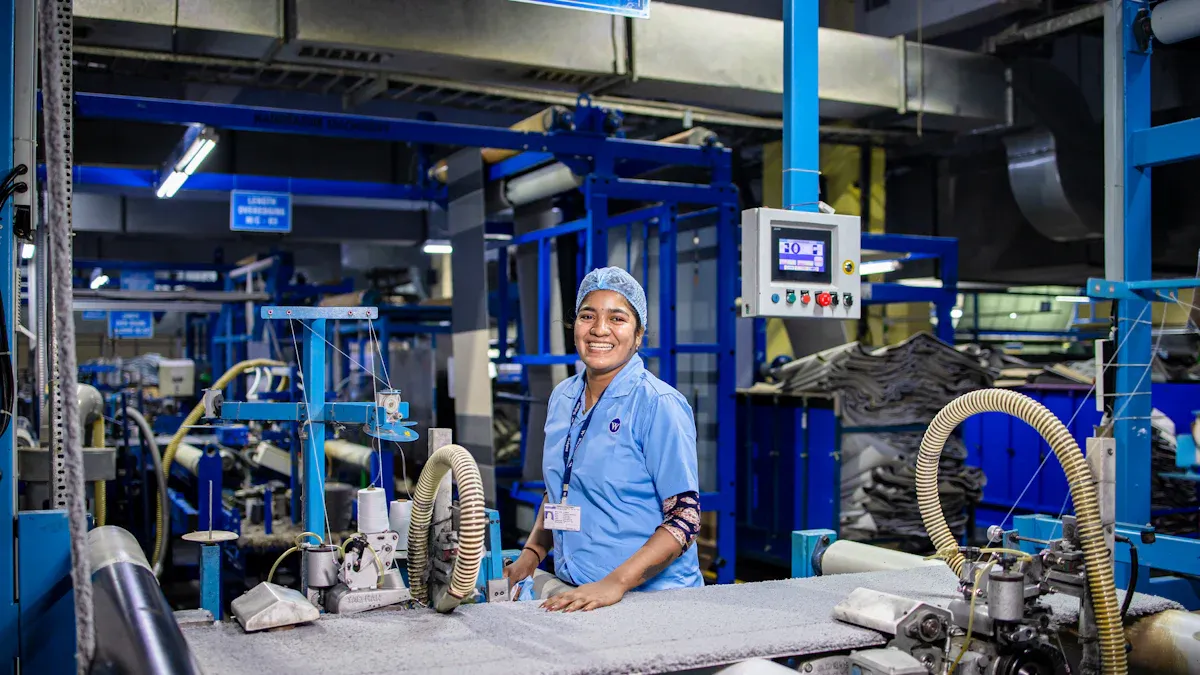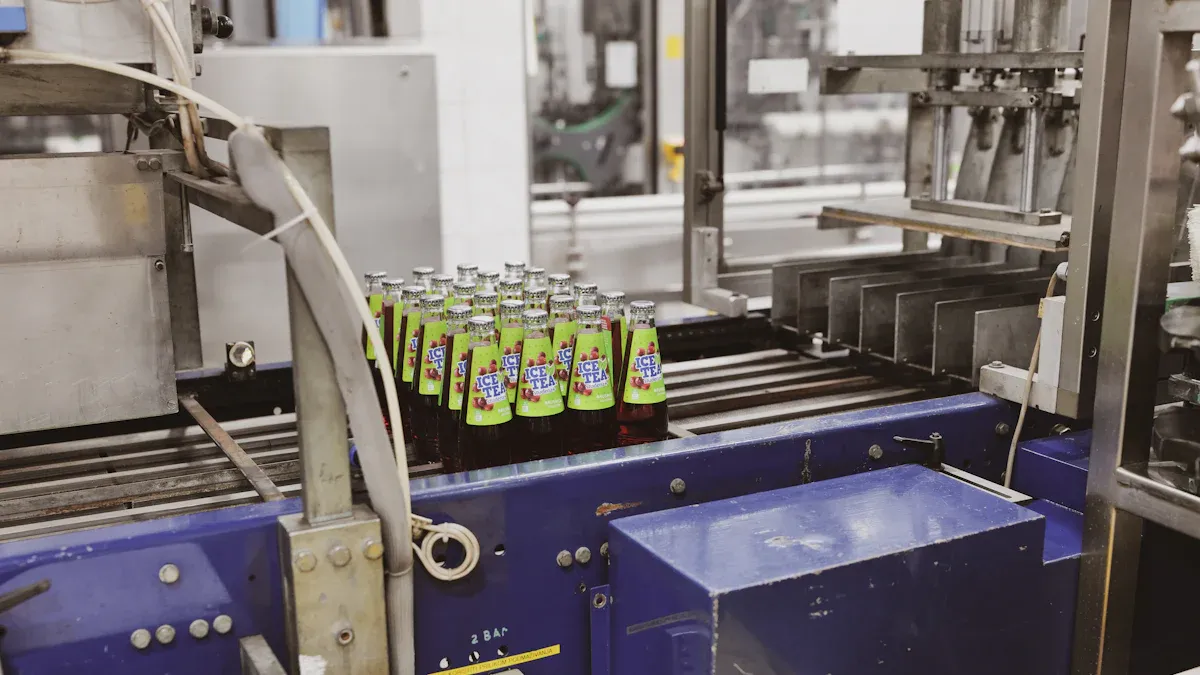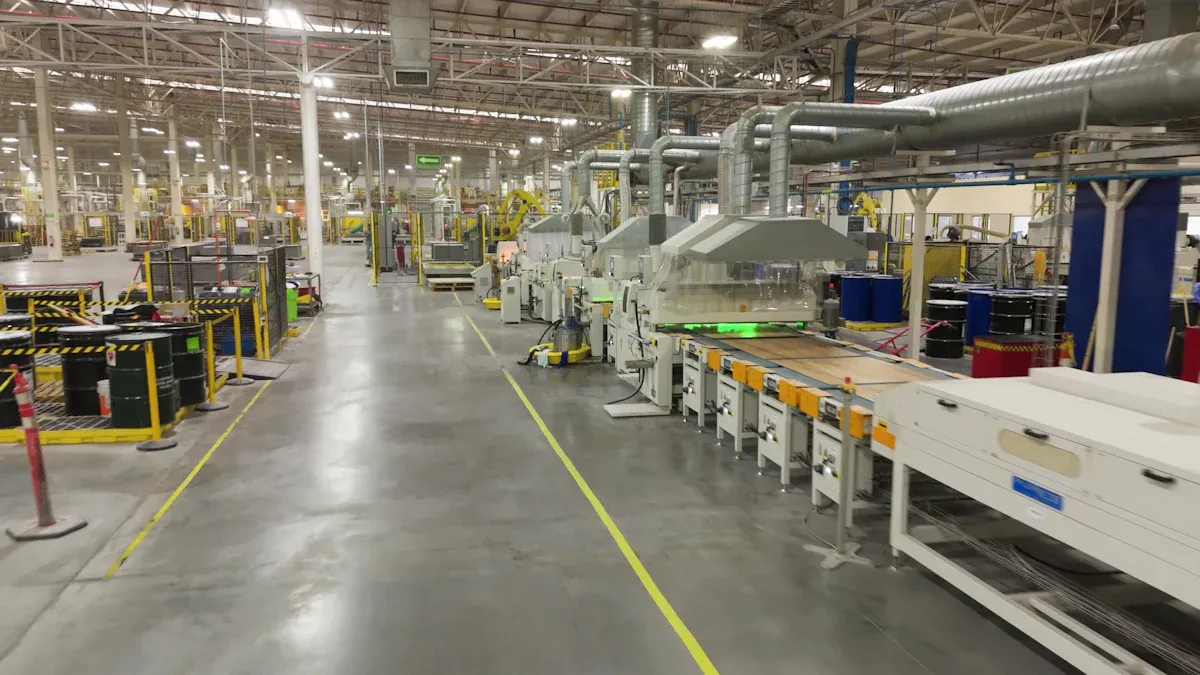
Scaling from prototype to mass production is vital in the OEM coffee machine industry. This transition meets the growing demand for high-quality, fully automatic coffee machines. The market is projected to grow from USD 4.95 billion in 2024 to USD 7.08 billion by 2033, driven by urbanization, home brewing trends, and expanding coffee shop chains. Manufacturers face challenges like maintaining quality and optimizing workflows, but these also present opportunities to innovate. A structured approach ensures consistent production, aligning with consumer expectations for convenience and reliability.
Key Takeaways
- Moving from a prototype to mass production needs smart planning. Making designs simpler and using parts that fit together easily saves time and money.
- Fixing design problems early is very important. Testing the prototype carefully helps find mistakes, making the final product reliable and keeping customers happy.
- Picking the right factory partner is key to doing well. Check how good suppliers are and make sure they match your goals for steady quality.
Design Readiness
Optimizing for Manufacturability
Transitioning from a prototype to mass production requires careful consideration of manufacturability. Engineers and designers must ensure that every component of the coffee machine can be produced efficiently without compromising quality. This process involves simplifying complex designs, reducing assembly time, and minimizing waste during production. For example, modular designs allow manufacturers to assemble parts more quickly, improving overall efficiency.
Energy efficiency also plays a critical role in manufacturability. Coffee machines with lower energy consumption not only appeal to environmentally conscious consumers but also reduce production costs. The following table highlights energy benchmarks for different types of coffee machines:
| Type of Coffee Machine | Energy Consumption (kWh/year) | Energy Saving Potential (kWh/year) |
|---|---|---|
| High Efficiency | 50 | 120 |
| Capsule Machines | < 40 | 120 |
| Typical Espresso | Varies | 120 |
By optimizing for manufacturability, OEM coffee machine producers can streamline production while meeting energy efficiency standards.
Addressing Design Flaws
Identifying and correcting design flaws is essential before scaling to mass production. Flaws discovered during the prototype phase can lead to significant issues if left unresolved. Manufacturers must conduct rigorous testing to uncover potential problems and implement effective solutions.
For instance, previous coffee machine prototypes revealed common issues such as load cell drift, app functionality errors, and flooding risks. The table below outlines how these flaws were addressed:
| Design Flaw | Correction |
|---|---|
| Load cell drift | Isolated variables to identify causes of drift, resulting in stable readings. |
| App functionality issues | Recognized that firmware issues needed addressing beyond app parameters. |
| Flooding risk | Implemented strict timeouts to prevent flooding during operation. |
By addressing these flaws early, manufacturers can ensure the reliability and durability of their coffee machines, enhancing customer satisfaction.
Material Selection and Cost Efficiency
Material selection directly impacts the cost, durability, and performance of coffee machines. Manufacturers must balance quality with cost efficiency to produce machines that are both affordable and reliable. High-quality materials, such as stainless steel for grinders or BPA-free plastics for water reservoirs, ensure durability and safety.
Cost efficiency can be achieved by sourcing materials in bulk or partnering with reliable suppliers. For example, OEM coffee machine manufacturers often collaborate with trusted vendors to secure high-quality components at competitive prices. This approach not only reduces production costs but also ensures consistency in the final product.
Additionally, sustainable materials are becoming increasingly important in the industry. Using recyclable or eco-friendly materials aligns with consumer preferences and reduces environmental impact. By prioritizing material selection and cost efficiency, manufacturers can create coffee machines that meet market demands while maintaining profitability.
Selecting the Right Manufacturer
Sourcing and Shortlisting
Finding the right manufacturer begins with a robust sourcing and shortlisting process. Businesses often rely on performance measurement tools to evaluate potential suppliers. Key performance indicators (KPIs) such as on-time delivery, product quality, and customer satisfaction provide valuable insights into a supplier’s reliability. Analyzing these metrics helps identify areas for improvement and mitigate risks.
Supplier evaluation also plays a crucial role. This process combines quantitative and qualitative assessments to ensure alignment with business values and strategies. By maintaining a portfolio of top-tier suppliers, companies can secure consistent quality and foster continuous improvement. For OEM coffee machine manufacturers, this approach ensures that only the most capable partners are considered.
Auditing and Evaluating Partners
Auditing potential manufacturing partners ensures they meet industry standards and align with business goals. Companies often assess adherence to certifications like GS, CB, CE, and RoHS. These certifications guarantee compliance with safety and environmental regulations.
A detailed evaluation also includes reviewing after-sales services. Reliable manufacturers offer benefits such as free spare parts, field maintenance, and repair services. Intellectual property protection is another critical factor. Manufacturers must safeguard designs and prevent unauthorized disclosures, ensuring client trust.
Compatibility and Capabilities Assessment
Compatibility between a business and its manufacturing partner is essential for long-term success. Manufacturers must demonstrate the ability to customize products, especially for small businesses. Offering discounts and tailored solutions fosters strong partnerships.
Capabilities assessment involves evaluating production capacity, technological expertise, and alignment with market demands. For instance, manufacturers specializing in fully automatic coffee machines must showcase advanced technology and efficient workflows. This ensures they can meet the growing demand for high-quality coffee machines.
Pilot Production and Testing

Small-Scale Production Runs
Pilot production serves as a bridge between prototyping and mass production. Manufacturers initiate small-scale production runs to validate the design and manufacturing processes. These runs help identify potential inefficiencies and ensure that the coffee machine performs as intended under real-world conditions. By producing a limited batch, manufacturers can test assembly workflows, evaluate material performance, and assess the overall production timeline. This phase also allows for the refinement of packaging and shipping methods, ensuring the product reaches customers in pristine condition.
Identifying Process Issues
Small-scale production often reveals process issues that may not surface during prototyping. Common problems include incomplete combustion caused by insufficient oxygen or clogged natural gas apertures. These issues can lead to uneven heating and soot production, which compromise the coffee machine’s performance. Visual inspections of burners often reveal bright yellow flames, a clear indicator of incomplete combustion. Addressing these problems typically involves labor-intensive cleaning or replacing burners. Identifying such issues early prevents costly delays during mass production and ensures a reliable product.
Refining Based on Feedback
Feedback from pilot production is invaluable for refining the manufacturing process. Engineers and production teams analyze data from small-scale runs to make necessary adjustments. For example, if assembly times are longer than expected, they may redesign components to simplify the process. Similarly, if material performance falls short, alternative materials are tested to enhance durability and efficiency. This iterative approach ensures that the final product meets quality standards and customer expectations. By incorporating feedback, manufacturers of OEM coffee machines can deliver a product that is both reliable and scalable.
Ensuring Compliance and Certification
Meeting Industry Standards
Compliance with industry standards ensures the safety, performance, and reliability of coffee machines. Manufacturers must adhere to established guidelines to meet consumer expectations and regulatory requirements. Standards such as UL 197 and UL 1082 focus on the safety of commercial and household electric coffee machines. Similarly, IEC 60335-2-15 ensures household machines meet electrical safety benchmarks. Food protection standards like NSF/ANSI 4-2009 address sanitation, while performance standards such as IEC 60661 evaluate coffee quality, energy consumption, and brewing efficiency.
| Standard Type | Standard Name | Description |
|---|---|---|
| Safety Standards | UL 197 | Commercial Electric Coffee Machine Standard |
| Safety Standards | UL 1082 | Household Electric Coffee Machine Standard |
| Safety Standards | UL 60730-2-9 | Temperature Sensing Control Standard |
| Safety Standards | IEC 60335-2-15 | Household Electric Coffee Machine Standard |
| Food Protection Standards | NSF/ANSI 4-2009 | Food Protection and Sanitation Standard |
| Performance Standards | IEC 60661 | Evaluates coffee quality, energy consumption, and output time |
| Performance Standards | ANSI/AHAM CM-1-2007 | Guidelines for comparing and evaluating performance |
By adhering to these standards, OEM coffee machine manufacturers can ensure their products meet global safety and performance expectations.
Performance and Durability Testing
Thorough testing guarantees that coffee machines perform reliably under various conditions. General use and care tests evaluate the ease of unboxing, setup, and user experience. Timing and taste tests assess brewing speed and coffee quality for different roasts and batch sizes. Brewing temperature tests ensure water temperatures meet Specialty Coffee Association (SCA) standards of 195-205˚F. Heat retention tests monitor how long coffee stays hot after brewing, ensuring customer satisfaction.
These tests provide valuable insights into the durability and reliability of coffee machines. By addressing any shortcomings during this phase, manufacturers can refine their designs and deliver high-quality products.
Certification Processes
Certification validates that coffee machines comply with industry standards and regulations. Organizations like UL and NSF conduct rigorous evaluations to certify safety, sanitation, and performance. The certification process involves detailed inspections, including electrical safety checks, material assessments, and operational tests. Once certified, products gain credibility and access to broader markets.
For OEM coffee machine manufacturers, achieving certifications like UL 197 or NSF/ANSI 4-2009 demonstrates a commitment to quality and safety. These certifications reassure consumers and build trust in the brand.
Scaling to Mass Production

Streamlining Workflows
Efficient workflows are the backbone of successful mass production. Manufacturers must focus on eliminating inefficiencies and integrating technology to optimize operations. Synergies across departments often lead to significant productivity gains. For instance:
- Companies that digitize their operations can achieve cost savings of up to 30%.
- Streamlining processes through technology integration unlocks cost savings and improves productivity.
Lean manufacturing principles, widely adopted in industries comparable to coffee machines, emphasize waste reduction and continuous improvement. This approach ensures that every step in the production process adds value. Best practices include:
- Optimizing inventory management with technologies like RFID for real-time tracking.
- Enhancing supplier relationships to negotiate better terms and reduce lead times.
- Improving logistics operations through GPS tracking and route optimization.
Benchmarking against industry leaders also helps manufacturers identify areas for improvement. By adopting best practices, OEM coffee machine producers can enhance operational efficiency, reduce costs, and meet growing market demands.
Quality Control Implementation
Quality control ensures that every coffee machine meets the highest standards before reaching consumers. Rigorous testing and process controls play a crucial role in maintaining consistency and reliability. For example, Starbucks has implemented AI coffee makers to enhance productivity, demonstrating the link between quality control systems and improved production efficiency. Similarly, Realcafé replaced a metal detector with the Russell Compact Sieve, increasing productivity and reducing product wastage.
Manufacturers must establish robust quality control systems that include:
- Regular inspections to identify defects early in the production process.
- Automated testing to ensure consistent performance across all units.
- Continuous monitoring of production lines to maintain high standards.
These measures not only improve product quality but also build consumer trust. By prioritizing quality control, OEM coffee machine manufacturers can deliver reliable products that meet customer expectations.
Supply Chain and Logistics Management
A well-managed supply chain is essential for scaling to mass production. Centralization and standardization simplify production processes and enhance efficiency. Vertical integration minimizes transaction costs by consolidating multiple stages of the supply chain. Global sourcing allows manufacturers to take advantage of international price disparities, reducing costs while maintaining quality.
Capacity expansion is another critical factor. Investing in larger facilities enables manufacturers to increase production volumes and meet growing demand. Collaborative partnerships with other firms can also lead to cost savings by sharing distribution networks and resources.
Financial planning plays a key role in ensuring scalability. Project economics for establishing a coffee maker manufacturing plant include analyzing capital expenditures, operational costs, and profitability. This comprehensive approach ensures that manufacturers can scale production efficiently while maintaining financial viability.
Transitioning from prototype to mass production involves critical steps that ensure success. These include pilot runs, certification, and continuous improvement. Preparation and testing minimize risks, as seen in the Lily camera drone case, where insufficient planning led to failure despite $34 million in pre-sales. A structured process guarantees scalable, high-quality coffee machines.
FAQ
What is the typical timeline for transitioning from prototype to mass production?
The timeline varies based on complexity. For coffee machines, it typically takes 6-12 months, including design refinement, pilot production, and certification.
How do manufacturers ensure consistent quality during mass production?
Manufacturers implement rigorous quality control systems. These include automated testing, regular inspections, and continuous monitoring to ensure every unit meets high standards.
Why is certification important for OEM coffee machines?
Certification ensures compliance with safety, performance, and sanitation standards. It builds consumer trust and allows products to enter global markets confidently.
Post time: Apr-15-2025
